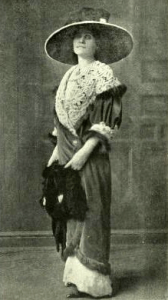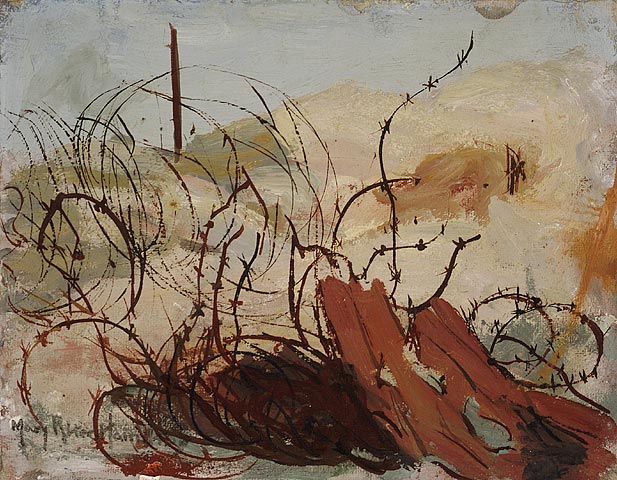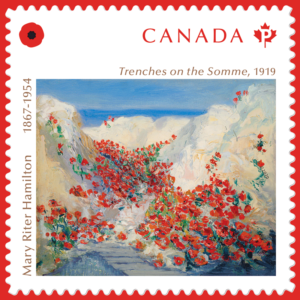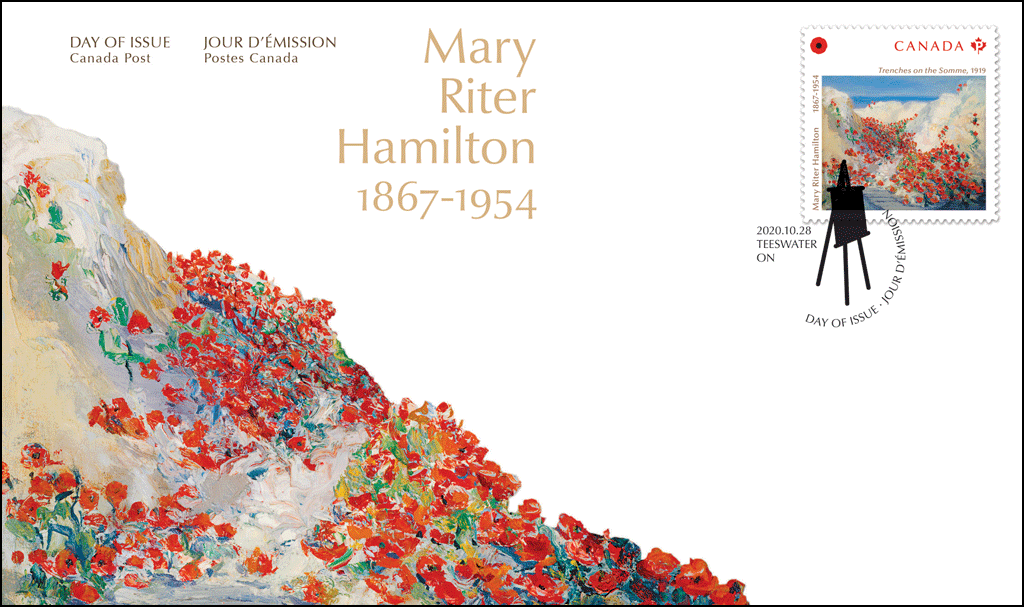 Canada Post will issue a stamp or stamps to honor Hamilton on October 28th. (press release below)
Canada Post will issue a stamp or stamps to honor Hamilton on October 28th. (press release below)
Called “Canada’s First Woman Artist,” Hamilton (1873-1954) recorded the aftermath of World War I by painting the battlefields in France and Belgium. She was born in Ontario, but grew up in Manitoba. She donated more than two hundred of her works to the Canadian Public Archives, and in 1988, War Amputations of Canada released No Man’s Land a documentary short focusing on Mary Riter Hamilton.
You can read more about her in Wikipedia, and the Library and Archives of Canada also has a page and podcast about her.  War Material, c. 1920
War Material, c. 1920
[press release]
Canada Post salutes country’s unofficial first woman battlefield artist
Remembrance Day stamp issue features the work of Mary Riter Hamilton
 OTTAWA – Canada Post on October 28th released a new stamp issue featuring Mary Riter Hamilton’s Trenches on the Somme (1919) in honour of the painter, who was unofficially Canada’s first woman battlefield artist.
OTTAWA – Canada Post on October 28th released a new stamp issue featuring Mary Riter Hamilton’s Trenches on the Somme (1919) in honour of the painter, who was unofficially Canada’s first woman battlefield artist.
Born in Teeswater, Ontario, and widowed in her 20s, Riter Hamilton studied art in Toronto, Berlin and Paris, and received critical acclaim for her first cross-Canada exhibition in 1911-12. Living in Victoria and Vancouver during the First World War, she applied to the Canadian government to be sent to the frontlines to document Canada’s military efforts but was refused based on her gender. In 1919, she received a commission from the Amputation Club of British Columbia (now The War Amps) to paint the battlefields of France and Belgium for its veterans’ magazine, The Gold Stripe.
Arriving in Europe in March 1919, she travelled independently to the sites of Canadian battles such as Vimy Ridge, Ypres and the Somme. Over two and a half years, she produced more than 300 paintings, drawings and etchings, capturing the destruction and the reconstruction efforts. She often painted in the cold, travelled long distances on foot, and had inadequate shelter and little food or money.
Commended for her talent and courage, she was awarded France’s Ordre des Palmes académiques in 1922. She remained in Europe, supporting herself by painting silk scarves, one of which won a gold medal at the Exposition internationale des arts décoratifs et industriels modernes in Paris in 1925. Returning to Canada that year, she found little interest in her paintings and donated most of her work to the Public Archives of Canada (now part of Library and Archives Canada).
In later years, her health suffered, due in part to her arduous living conditions on the battlefields. She died on April 5, 1954.
The booklet of 10 Permanent™ domestic rate stamps is the work of Montréal-based graphic designer Réjean Myette and was printed by Canadian Bank Note. An Official First Day Cover is also available.
Stamps and collectibles are available at canadapost.ca/shop.  [en Francais]
[en Francais]
Postes Canada salue la première artiste de champs de bataille à titre officieux au pays
Le timbre émis à l’occasion du jour du Souvenir illustre une œuvre de Mary Riter Hamilton
OTTAWA – 28 Octobre, Postes Canada a émis un nouveau timbre qui illustre l’œuvre de  Mary Riter Hamilton intitulée Trenches on the Somme (1919) en l’honneur de cette peintre qui est, à titre officieux, la première artiste canadienne de champs de bataille.
Mary Riter Hamilton intitulée Trenches on the Somme (1919) en l’honneur de cette peintre qui est, à titre officieux, la première artiste canadienne de champs de bataille.
Née à Teeswater, en Ontario, et devenue veuve dans la vingtaine, elle étudie les arts à Toronto, à Berlin et à Paris. En 1911 et 1912 se tient sa première exposition pancanadienne, encensée par la critique. Mary Riter Hamilton, qui habite à Victoria et à Vancouver pendant la Première Guerre mondiale, propose au gouvernement canadien de l’envoyer au front pour témoigner des efforts militaires du Canada, mais sa demande est refusée en raison de son sexe. En 1919, l’Amputation Club of British Columbia (aujourd’hui Les Amputés de guerre) l’embauche pour peindre les champs de bataille en France et en Belgique pour son magazine The Gold Stripe destiné aux anciens combattants.
À son arrivée en Europe en mars 1919, elle se rend seule sur les champs de bataille où ont combattu des Canadiens, dont la crête de Vimy, Ypres et la Somme. Pendant plus de deux ans et demi, elle réalise plus de 300 peintures, dessins et esquisses qui témoignent de la destruction et des efforts de reconstruction. Elle peint souvent exposée au froid, parcourt de longues distances à pied et vit dans des abris de fortune avec peu de nourriture et d’argent.
En 1922, elle reçoit l’Ordre des Palmes académiques de France et elle est félicitée pour son talent et sa bravoure. Elle prolonge son séjour en Europe et y gagne sa vie en peignant des foulards en soie, dont un qui lui vaut une médaille d’or à l’Exposition internationale des arts décoratifs et industriels modernes à Paris en 1925. Après son retour au Canada cette année-là, ses créations suscitant peu d’intérêt, elle fait don de la plupart de ses œuvres à Archives publiques Canada (aujourd’hui Bibliothèque et Archives Canada).
Des années plus tard, sa santé se détériore, entre autres en raison des conditions difficiles dans lesquelles elle a vécu sur les champs de bataille. Elle décède le 5 avril 1954.
Le carnet de 10 timbres PermanentsMC au tarif du régime intérieur a été conçu par Réjean Myette, graphiste à Montréal, et imprimé par Canadian Bank Note. Un pli Premier Jour officiel est aussi offert.
Les timbres et les articles de collection sont disponibles en ligne à postescanada.ca/magasiner.



